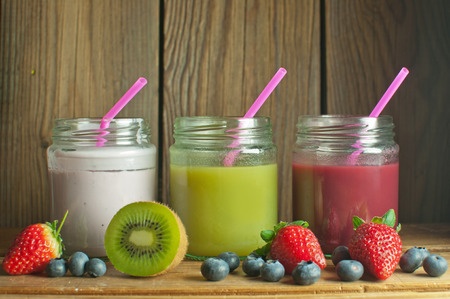Are smoothies healthy? You would think so. After all we read about how healthy they are all the time. The truth is that they can be healthy or unhealthy, depending on the ingredients and your particular diet.
Are Smoothies Healthy?
If your choices for a quick breakfast on the go are limited, however, a smoothie might not be the worst choice. “If you can’t always sit down and include healthy foods, combining them into a well-rounded smoothie can be an option — if done in a healthy way, it may be better than not eating them at all,” Dr. Gupta said. And smoothies, according to Dr. Gupta, are much better than juices, which have even less fiber.
So if a smoothie is your best bet for squeezing some fruits and vegetables into your diet, that’s probably OK — just don’t go overboard. And per Kaufman’s advice, add a portion of protein as well.
“Just be careful about how often you’re having them, the amount that you’re having, the sugar content of what you’re adding, and added sugars/ingredients,” Dr. Gupta said.
But, starting your day with a smoothie might not be as healthy as you think.
Here’s why:
• Smoothies have all the sugar and calories without all the fiber of whole fruits.
• Fiber helps with satiety, which is important for weight management as well as the prevention of some chronic diseases.
• If a smoothie is the only way you’re going to get fruits and vegetables into your diet, don’t go overboard and watch out for added sugars.
A cup of blended fruit may seem like a super healthy way to start your day, and it’s certainly got some genuine advantages over less nutrient-dense, more dessert-like breakfast foods. But smoothies don’t actually have the golden health halo they’re often made out to.
We spoke with some nutrition experts about some of the reasons smoothies don’t deserve their reputation as a “health food.”
Some of the fiber naturally present in whole fruit is pulverized
Blended fruit isn’t nutritionally equivalent to the same fruit left whole, according to some experts. Although, of course, some properties remain present, including soluble fiber, blending can break down insoluble fiber.
“The reason I usually recommend eating whole vegetables and fruits, rather than drinking them, is that the fibrous and pulpy parts contain valuable nutrients, and also serve to fill you up,” Dr. Alka Gupta, co-director of the Integrative Health & Wellbeing Program at New York-Presbyterian and Weill Cornell Medicine told INSIDER. “Soluble and insoluble fibers are crucial for the digestive process — they ensure that we digest and absorb nutrients and sugars slowly, avoiding a quick spike in blood sugars. They also add bulk to our stool, and help to keep our gastrointestinal system moving regularly.”
It’s well-known that fruits and veggies contain lots of vitamins, but their insoluble fiber content is an unsung hero. It plays a role in weight management and may help prevent chronic diseases like diabetes. Gupta also said that fiber is important for cardiovascular health.
“When it comes to breakfast, you want to make sure that it is high in fiber and rich in protein to keep you satiated for the rest of the morning,” Leah Kaufman, MS, registered dietitian at NYU Langone’s Weight Management Program told INSIDER. A smoothie’s protein content can be boosted with nuts, nut butter, or protein powder, but if not, the lack of protein and fiber combined could lead to you feeling hungry again before lunch.
But it’s worth noting that more research is needed about how your body digests insoluble fiber once it’s broken down in this form. Some experts agree blending reduces fiber content, while others are skeptical.
Smoothies often contain a lot of sugar and calories
More isn’t always better, even when it comes to generally healthy foods like fruit and veggies. Kaufman estimated that the average smoothie from a smoothie shop may use up to six times the recommended portion of fruit, such as three whole bananas to the recommended one-half.
“When we combine these foods into a smoothie, it becomes quite easy to drink a much higher amount of calories and sugar (from just the foods themselves), than when we’re eating the whole foods,” Gupta said. “When you think about a fruit-based 20-ounce smoothie, it probably contains a lot more fruit than we’d usually eat in one sitting.”
This volume, combined with the satiety factor you’re missing out on from the fiber that’s been destroyed, means that smoothies make it easier to overdo it on calories and sugar. Both store-bought and homemade smoothies could include added sugars as well, such as in the form of pre-sweetened fruit juices or yogurts.
Click here to read full article about are smoothies healthy.






